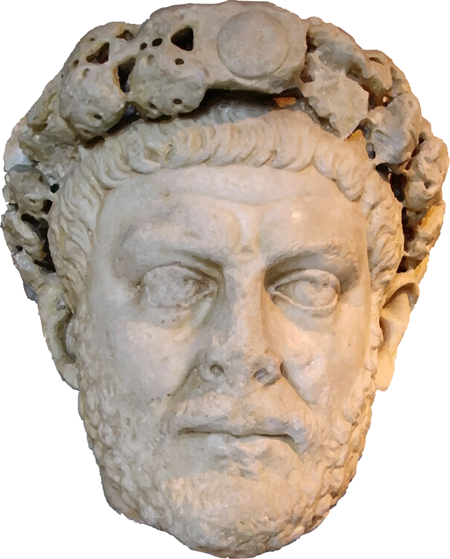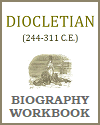Emperor Diocletian, born on December 22, A.D. 244, in Dalmatia (modern-day Croatia), was a Roman emperor who ruled from A.D. 284 to A.D. 305. He is best known for his significant administrative reforms, which brought stability to the Roman Empire during a period of intense turmoil and set the stage for the empire’s division into East and West.
 Diocletian rose to power after the assassination of Emperor Numerian, and his reign marked the end of the Crisis of the Third Century--a time of severe instability characterized by frequent changes of rulers, civil wars, and external invasions. Recognizing the vastness of the Roman Empire and the challenges of governing it effectively, Diocletian implemented a radical new system of governance known as the Tetrarchy in A.D. 293. He divided the empire into two parts, East and West, and appointed a co-emperor (Augustus) to rule each half, along with two junior emperors (Caesars) to assist them. This system was designed to ensure smoother succession and more effective management of the empire’s extensive territories.
Diocletian rose to power after the assassination of Emperor Numerian, and his reign marked the end of the Crisis of the Third Century--a time of severe instability characterized by frequent changes of rulers, civil wars, and external invasions. Recognizing the vastness of the Roman Empire and the challenges of governing it effectively, Diocletian implemented a radical new system of governance known as the Tetrarchy in A.D. 293. He divided the empire into two parts, East and West, and appointed a co-emperor (Augustus) to rule each half, along with two junior emperors (Caesars) to assist them. This system was designed to ensure smoother succession and more effective management of the empire’s extensive territories.
 Diocletian also undertook comprehensive economic and military reforms. He restructured the empire's tax system to increase revenue and introduced measures to curb inflation, such as issuing a new, stable currency. To fortify the empire’s defenses, he reorganized the military, strengthening frontier defenses and creating a more mobile central army to respond to threats more rapidly.
Diocletian also undertook comprehensive economic and military reforms. He restructured the empire's tax system to increase revenue and introduced measures to curb inflation, such as issuing a new, stable currency. To fortify the empire’s defenses, he reorganized the military, strengthening frontier defenses and creating a more mobile central army to respond to threats more rapidly.
One of the most controversial aspects of Diocletian's reign was his persecution of Christians, known as the Diocletianic Persecution, beginning in A.D. 303. This was the last and most severe persecution of Christians in the Roman Empire, aiming to revive traditional Roman religious practices.
Diocletian's health began to decline, and in A.D. 305, he took the unprecedented step of voluntarily abdicating the throne, retiring to his palace in Split, Dalmatia. His abdication was intended to ensure a smooth succession under the Tetrarchic system. Diocletian died in A.D. 311, leaving behind a legacy of significant administrative and military reforms that temporarily stabilized the Roman Empire and influenced its future governance.
|
 Diocletian rose to power after the assassination of Emperor Numerian, and his reign marked the end of the Crisis of the Third Century--a time of severe instability characterized by frequent changes of rulers, civil wars, and external invasions. Recognizing the vastness of the Roman Empire and the challenges of governing it effectively, Diocletian implemented a radical new system of governance known as the Tetrarchy in A.D. 293. He divided the empire into two parts, East and West, and appointed a co-emperor (Augustus) to rule each half, along with two junior emperors (Caesars) to assist them. This system was designed to ensure smoother succession and more effective management of the empire’s extensive territories.
Diocletian rose to power after the assassination of Emperor Numerian, and his reign marked the end of the Crisis of the Third Century--a time of severe instability characterized by frequent changes of rulers, civil wars, and external invasions. Recognizing the vastness of the Roman Empire and the challenges of governing it effectively, Diocletian implemented a radical new system of governance known as the Tetrarchy in A.D. 293. He divided the empire into two parts, East and West, and appointed a co-emperor (Augustus) to rule each half, along with two junior emperors (Caesars) to assist them. This system was designed to ensure smoother succession and more effective management of the empire’s extensive territories.
 Diocletian also undertook comprehensive economic and military reforms. He restructured the empire's tax system to increase revenue and introduced measures to curb inflation, such as issuing a new, stable currency. To fortify the empire’s defenses, he reorganized the military, strengthening frontier defenses and creating a more mobile central army to respond to threats more rapidly.
Diocletian also undertook comprehensive economic and military reforms. He restructured the empire's tax system to increase revenue and introduced measures to curb inflation, such as issuing a new, stable currency. To fortify the empire’s defenses, he reorganized the military, strengthening frontier defenses and creating a more mobile central army to respond to threats more rapidly.







